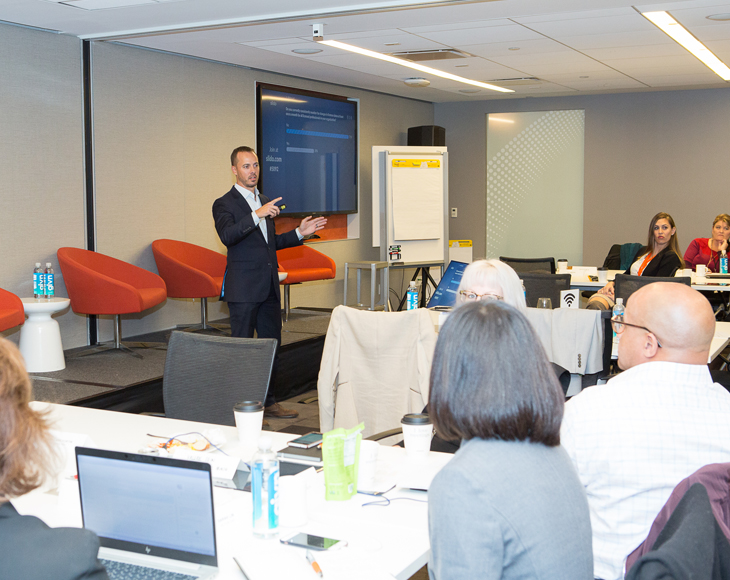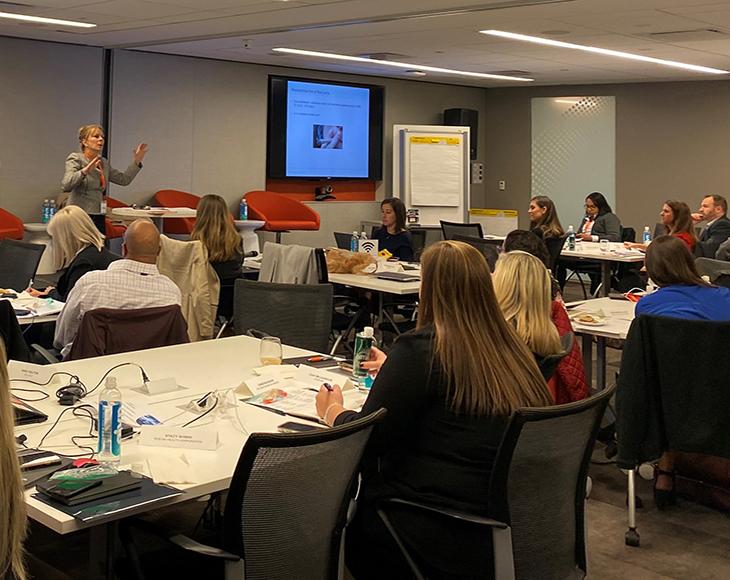December 17th, 2019 | Sterling
Sterling’s 4th Annual Healthcare and Life Sciences Summit Day 2

Author: Val Poltorak, General Manager, Healthcare and Life Sciences
After lunch, summit attendees eagerly took their seats to participate in the afternoon’s sessions. Need to catch up? Read our Day One recap here, and Day Two, Part One here.
What the Joint Commission Wants to See
In the first of the afternoon sessions, participants were given a choice of topics. Connie Pullen, Consultant for Joint Commission Resources, Inc., led a discussion entitled, “What the Joint Commission Wants to See: Ensuring a Successful Survey Utilizing Proven Audit Tools and Documentation Best Practices.”
Connie outlined the mission of the Joint Commission and discussed its relationship to the Center for Medicare & Medicaid (CMS), and state administrative rules. A key question was which standards are to be followed? The answer was – it depends. Organizations should always follow the stricter standard. The Joint Commission accreditation and deemed status; while CMS is certification to receive Medicare and Medicaid payments; and State Administrative Rules assure licensure.
She then took a deep dive into the Joint Commission’s Accreditation Programs and Process. Attendees had many questions, mostly regarding policies and how to ensure a successful survey. Connie quoted an old phrase as a solution to many problems, “When there is not a policy, then create a policy and stick to that policy. If you cannot stick to the policy, then revise it.”
At the same time, Sterling’s Vice President of Product, Nathan Anderson, spoke to a group about the challenges and opportunities of . He explored challenges surrounding license monitoring, citing “Do It Yourself” (in-house) monitoring solutions that cause not only an administrative burden, but also leave the company open to high levels of risk if not performed, or even when performed improperly.
Nathan shared models that illustrated the risks of only conducting sanctions monitoring, where a company’s risk exposure period is far longer than the license monitoring model, where the risk period is far shorter.
Applying technology and automation to medical license expiration tracking and license status monitoring can be game-changers, providing greater consistency, faster time-to-hire and increased accuracy.
The percentage of attendees whose companies conduct ongoing monitoring was mixed. But the general consensus was that the industries should adopt monitoring and embrace technology far more than they currently do, not only to mitigate risk but to increase .For a deeper dive into workforce monitoring, you can download Sterling’s “The New Reality of Workforce Monitoring” white paper.
The Plus Points of Volunteer Programs
After lunch, there were two more breakout sessions. Eileen McConville, Principal and Founder of Vision Volunteering, spoke about creating effective recruitment, screening, and management for a volunteer program.
Eileen discussed the importance of screening volunteers, various requirements for hospital-based programs, and how attendees can develop tools to support and expand programs.
The healthcare industry faces a record staffing shortage, while roughly 10,000 baby boomers1 retire every day. This provides organizations with an opportunity to leverage volunteer programs. Eileen shared tips for recruiting volunteers and how to provide a “hassle-free” onboarding process.
Several attendees discussed their volunteer programs and welcomed the insights that Eileen provided.
Establishing Workplace Safety Programs
HR’s role in mitigating workplace violence was another session available to summit attendees. Paul Sarnese, Associate Vice President, Safety, Security & Emergency Preparedness for Virtua Health, shared insights, and real-life stories of workplace violence he has dealt with.
Paul discussed how OSHA, the Joint Commission and other organizations have varying definitions of workplace violence. He shared stats as well as strategies for a sound violence prevention program.
While discussing essential elements of a prevention program, he highlighted HR’s role in creating and managing it. The essential elements include management commitment, worksite analysis, hazard prevention and control, safety and health training, and record-keeping and evaluation of the program.
The HR team should set the tone for acceptable behavior, conduct thorough background screenings, assess formal and informal report of concern, and implement a timely response.
Paul also urged attendees to review their termination process. Factors included planning the set-up of the room and who is present, maintaining a safe distance, and the importance of having a predetermined distress signal.
The challenges of recruiting travel nurses was the next topic of discussion, led by Jim Puente, Director, Nurse Licensure Compact, NCSBN (National Council of State Boards of Nursing). As more organizations face a nurse shortage, they are turning to travel nurses to fill gaps. There are great opportunities in leveraging this talent pool, and challenges that recruiters need to tackle as well.
The group asked questions about if the compact license works across states, privilege to practice, time limitations and how best to leverage the advantages the compact provides.
Marijuana Legalization and its Impact on Healthcare Hiring

To close the summit, Tracy Armstrong, Shareholder at Wilentz, Goldman and Spitzer, P.A., discussed Cannabis Legislation: The Impact of Drug Use Decriminalization on the Workforce.
Tracy touched on the variety of legislation, and that although marijuana is still classified as a Schedule 1 substance (akin to heroin), several states now allow either medical or recreational use. This patchwork of varying regulations can be a veritable nightmare for healthcare and life sciences HR professionals.
Tracy, and the group at large, arrived at the conclusion, that each situation is unique. Because the laws surrounding this topic are changing at a break-neck pace, the best path is to consult legal counsel in the state or states in which the company does business, and where the employee resides.
A useful resource on this topic is Sterling’s recent webinar, “HR Legislation in the Stoned Age: Marijuana Legalization.” You can watch the on-demand recording of the webinar here.
In Conclusion
Speakers, industry thought leaders, and Sterling’s subject matter experts mingled with summit attendees after the sessions ended, discussing specific challenges, making connections, and talking about what lies ahead in 2020.
You can stay up-to-date with regulations, industry news and upcoming events by subscribing to Sterling’s Healthcare & Life Sciences Navigator e-newsletter. Important information you need delivered right to your inbox. Subscribe now.
1: Source: US Bureau of Labor Statistics, Occupational Outlook Handbook
Sterling is not a law firm. This publication is for informational purposes only and nothing contained in it should be construed as legal advice. We expressly disclaim any warranty or responsibility for damages arising out this information. We encourage you to consult with legal counsel regarding your specific needs. We do not undertake any duty to update previously posted materials.

